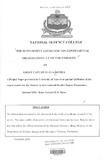| dc.description.abstract | Zimbabwe has had a long history dating back to the thirteenth century when the Munhumutapa Empire was established centered on the current Great Zimbabwe monument. The empire had a thriving civilization characterized by cultivation of subsistence crops, trade and iron smiting. Control over the vast empire was achieved through a centralized system of chiefs who reported to the Munhumutapa. The huge mineral endowment and rich soils where the major of power fro the rulers. Coincidentally the endowment with rich natural resources provided a strong attraction to the British imperialists who subsequently colonized the country.
The colonization of Zimbabwe was characteristically preceded by missionaries who established posts initially in the Eastern and Southern parts of the country. Their mission as with the rest of Africa was to spread Christianity. It was not long after some communities adopted Christianity its central tenet of non-violence that columns of settlers began infiltrating the country from the South using brutal force to suppress any resistance to their occupation. By 1896, the country had fallen into the hands of a settler regime.
The colonial state in Zimbabwe was built on the premise of a dual society with whites running an oppressive government system which marginalized the blacks. Indigenous systems were destroyed as they were considered to be backward and replaced by a colonial model which perpetrated the dependency of blacks. Whilst the exploitative system matured, the levels of poverty among blacks deepened. Private voluntary organizations with the majority being missionary societies emerged to assist especially
the handicapped and orphaned blacks. Their activities were restricted and closely monitored to ensure that they did not promote black unrest. To this extent assistance was only in the form of food, clothing and to a lesser extent medicine. The development of rural areas in which the majority of blacks lived lagged behind markedly with access to basic needs of education, health, clean water and sanitation being severely curtailed.
The advent of independence in 1980 brought hope among rural communities that their development needs were going to be satisfied. The period thereafter witnessed a flood of NGOs into the country. Their involvement was initially in relief work were focus was on assisting refugees returning home, responding to disasters which were drought inflicted and supporting small women’s clubs involved in sewing, baking and soap-making.
The focus of NGO activities soon changed to development initiatives in late 1980s. At this time the government was starting to show signs of financial stress. The Economic Structural Programs embarked on thereafter worsened the plight of rural communities as the government withdrew most of its support to Community Based Organizations which had become the major form of community development initiatives. International Non- Governmental Organizations registered their presence by filling the gap left by government. Their main contribution was financial in nature to other NGOs. Projects that were supported included the building of schools, hospitals and the sponsorship of research and extension. Some recognizable development was achieved in the rural communities. | en_US |



